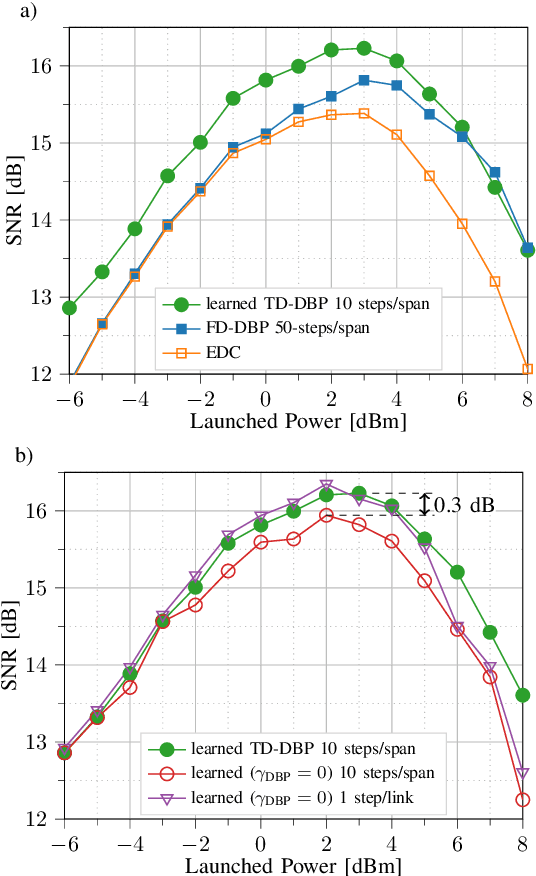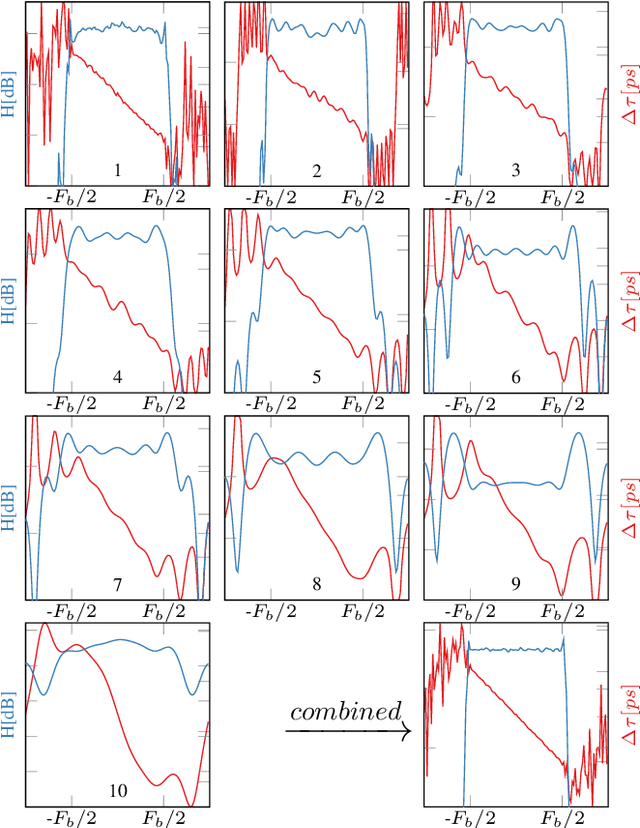Eric Sillekens
Measurement and Analysis of the Power Consumption of Hybrid-Amplified SCL-band Links
Jul 30, 2025



Abstract:We studied the power consumption of hybrid-amplified SCL-band links using commercial benchtop amplifiers and Raman pumps. We show a reduction in energy per bit for multi-span hybrid Raman amplified links of up to 26% versus lumped amplification.
Ultrawideband optical fibre throughput in the presence of total optical power constraints from C to OESCLU spectral bands
Jul 19, 2024



Abstract:Using a recently developed fast integral ultrawideband Gaussian noise model, we quantify the achievable throughput under total optical power constraints for systems ranging from C-band to fully populated OESCLU bands using optimum launch powers, showing conditions when expanding bandwidth provides no additional throughput.
Optimising O-to-U Band Transmission Using Fast ISRS Gaussian Noise Numerical Integral Model
Jan 31, 2024



Abstract:We model the transmission of ultrawideband (UWB) signals, including wavelength-dependent fibre parameters: dispersion, nonlinear coefficient and effective fibre core area. To that end, the inter-channel stimulated Raman scattering Gaussian noise (ISRS GN) integral model is extended to include these parameters. The integrals involved in this frequency-domain model are numerically solved in hyperbolic coordinates using a Riemann sum. The model implementation is designed to work on parallel graphics processing units (GPUs) and is optimised for fast computational time. The model is valid for Gaussian-distributed signals and is compared with the split-step Fourier method (SSFM), for transmission over standard single-mode fibre (SSMF) in the O-band (wavelengths around the zero-dispersion wavelength), showing reasonable agreement. Further, we demonstrated SNR evaluation over an 80 km SSFM single-span transmission using 589$\times$96 GBaud channels, corresponding to almost 59 THz optical bandwidth, fully populating the O, E, S, C, L and U bands (1260$-$1675 nm). The SNR evaluation is completed in just 3.6 seconds using four Nvidia V100 16GB PCIe GPUs. Finally, we used this model to find the optimum launch power profile for this system achieving 747 Tbps of potential throughput over 80 km fibre and demonstrating its suitability for UWB optimisation routines.
Throughput Maximisation in Ultra-wideband Hybrid-amplified Links
Nov 15, 2023

Abstract:A semi-analytical, real-time nonlinear-interference model including ASE noise in hybrid-amplified links is introduced. Combined with particle-swarm optimisation, the capacity of a hybrid-amplified 10.5 THz 117x57 km link was maximised, increasing throughput by 12% versus an EDFAs-only configuration.
Dual band wireless transmission over 75-150GHz millimeter wave carriers using frequency-locked laser pairs
Oct 27, 2023

Abstract:We generate and transmit 75-GHz-bandwidth OFDM signals over the air using three mutually frequency-locked lasers, achieving minimal frequency gap between the wireless W and D bands using optical-assisted approaches, resulting in 173.5 Gb/s detected capacity.
High-Cardinality Geometrical Constellation Shaping for the Nonlinear Fibre Channel
May 09, 2022



Abstract:This paper presents design methods for highly efficient optimisation of geometrically shaped constellations to maximise data throughput in optical communications. It describes methods to analytically calculate the information-theoretical loss and the gradient of this loss as a function of the input constellation shape. The gradients of the \ac{MI} and \ac{GMI} are critical to the optimisation of geometrically-shaped constellations. It presents the analytical derivative of the achievable information rate metrics with respect to the input constellation. The proposed method allows for improved design of higher cardinality and higher-dimensional constellations for optimising both linear and nonlinear fibre transmission throughput. Near-capacity achieving constellations with up to 8192 points for both 2 and 4 dimensions, with generalised mutual information (GMI) within 0.06 bit/2Dsymbol of additive white Gaussian noise channel (AWGN) capacity, are presented. Additionally, a design algorithm reducing the design computation time from days to minutes is introduced, allowing the presentation of optimised constellations for both linear AWGN and nonlinear fibre channels for a wide range of signal-to-noise ratios.
Experimental Demonstration of Learned Time-Domain Digital Back-Propagation
Dec 23, 2019



Abstract:We present the first experimental demonstration of learned time-domain digital back-propagation (DBP), in 64-GBd dual-polarization 64-QAM signal transmission over 1014 km. Performance gains were comparable to those obtained with conventional, higher complexity, frequency-domain DBP.
 Add to Chrome
Add to Chrome Add to Firefox
Add to Firefox Add to Edge
Add to Edge